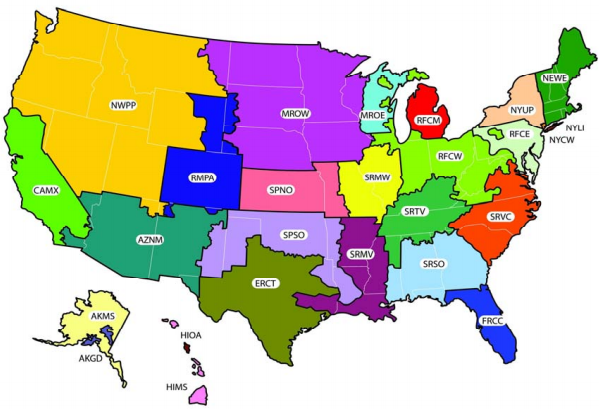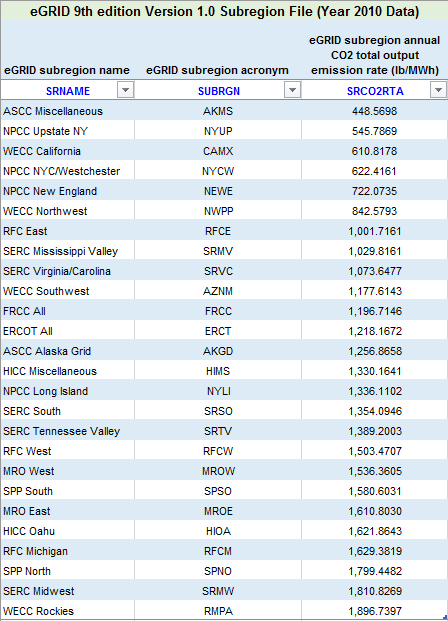 Did you know that one kWh of electricity used in Denver may emit almost four times as much carbon dioxide as one kWh used in Buffalo? Those indirect (Scope 2) emissions are what the Environmental Protection Agency (EPA) is now calling carbon pollution.
Did you know that one kWh of electricity used in Denver may emit almost four times as much carbon dioxide as one kWh used in Buffalo? Those indirect (Scope 2) emissions are what the Environmental Protection Agency (EPA) is now calling carbon pollution.
So just how dirty is your electricity? That depends on where you live across the country.
Behind the curtain that is the national electric grid for the United States lies a host of electric generators. Energy vendors tap a number of fuel sources and technologies to generate and supply the precise amount of electricity required to keep the nation’s three independent but interconnected power grids humming smoothly.
{{cta(’91fa5367-eab9-4407-aa35-f815a28dcf22′,’justifycenter’)}}
Grid Operations
Grid operators from the Western Interconnection, the Eastern Interconnection, and the Texas Interconnection negotiate with electricity generators in a lively day-ahead auction. You may be surprised to learn that the electricity you consume could be a lot dirtier than other electricity, even if it is feeding the same power grid.
So how can we tell which areas of the United States generate the dirtiest electricity?
It depends on how you define “dirty”, but one national standard is the Emissions and Generation Resource Integrated Database (eGRID), created by the Environmental Protection Agency (EPA).
eGRID
This comprehensive dataset includes various environmental characteristics—emissions of greenhouse gases, percentages of renewables vs. non-renewable fuels, net generation—for almost all electric power generated throughout the United States. You can find more details about the eGRID here.
The eGRID database groups electricity generation data from suppliers into subregions based on the location of the plants that generate electric power in each. There are about two dozen such regions, and you can find which one you live in using the map shown.

Source: EPA
eGRID collects data on power plants and power companies from various sources such as the EPA, Energy Information Administration (EIA), North American Electric Reliability Corporation (NERC) and Federal Energy Regulatory Commission (FERC). By compiling the data based on the subregions, eGRID makes it possible to compare certain environmental characteristics of electricity generation across the country.
The Dirtiest
One statistic used for comparison is the total CO2 output emission rate, expressed as lb/kWh. By ranking this metric, eGRID reveals that as of its 2010 data (the latest available), the top 5 dirtiest electric power generating regions were:
- RMPA (WECC Rockies)
- SRMW (SERC Mississippi Valley)
- SPNO (SPP North)
- RFCM (RFC Michigan)
- HIOA (HICC Oahu)
Can you find these on the map? Why do you think that these areas generate the highest emission rate? These locations include states such as Colorado, Indiana, Kansas, and Michigan that use cheap, soft coal to generate electricity. This results in higher equivalent CO2 emissions. HIOA, representing northern islands of Hawaii, uses mostly oil, which is another fossil fuel associated with higher equivalent CO2 emissions.
The Cleanest
So which subregions* generate the cleanest electric power, according to eGRID?
- NYUP (NPCC Upstate NY)
- CAMX (WECC California)
- NYCW (NPCC NYC/Westchester)
- NEWE (NPCC New England)
- NWPP (WECC Northwest)
*Results do not include subregion AKMS due to the very small population in this area of Alaska.
What are these subregions doing differently to generate cleaner electricity? Most of these areas—Pacific Northwestern states, Maine and New York—generated a larger percentage of their electricity from sources such as natural gas, hydropower and nuclear power. These plants all emit fewer pounds of CO2 per kilowatt-hour than sources including coal and oil. Interestingly, CAMX, which includes most of California, and RMPA, which includes most of Colorado, are both part of the Western Interconnection. But RMPA’s emission rate is over three times higher than CAMX.
The Data
Here is the raw data for the annual emissions rate comparison:

Click here to download and view the eGRID data to look more closely at the emissions from electric power generators in your subregion (the eGRID CO2 output is in units of pounds CO2 equivalent per megawatt hour. Divide by 1,000 for lb/kWh).
The Future
The last edition of eGRID was done using data from 2010. Since then, the fuel mix for U.S. electricity generation has shifted to using less coal and more “clean” natural gas (natural gas emits half the CO2 of coal). In April 2015, for the first time in our nation’s history, more electricity was generated from gas than coal. In addition, the percentages of wind, hydro and PV solar have risen since 2010.
As the country continues to develop new energy resources, it will be interesting to see how these emission numbers change. Keep your eyes open to see how your region is doing.
{{cta(’13b3128f-8bce-4991-b625-7df5aeb56a2e’,’justifycenter’)}}
 Best-in-class portfolio-level energy and utility bill data management and reporting.
Best-in-class portfolio-level energy and utility bill data management and reporting.
 Real-time energy and sustainability analytics for high-performance, net-zero buildings.
Real-time energy and sustainability analytics for high-performance, net-zero buildings.
 A holistic view of financial-grade scope 1, 2, and 3 carbon emissions data across your entire business.
A holistic view of financial-grade scope 1, 2, and 3 carbon emissions data across your entire business.
 Energy and sustainability benchmarking compliance software designed for utilities.
Energy and sustainability benchmarking compliance software designed for utilities.
 Did you know that one kWh of electricity used in Denver may emit almost four times as much carbon dioxide as one kWh used in Buffalo? Those indirect (Scope 2) emissions are what the
Did you know that one kWh of electricity used in Denver may emit almost four times as much carbon dioxide as one kWh used in Buffalo? Those indirect (Scope 2) emissions are what the 



